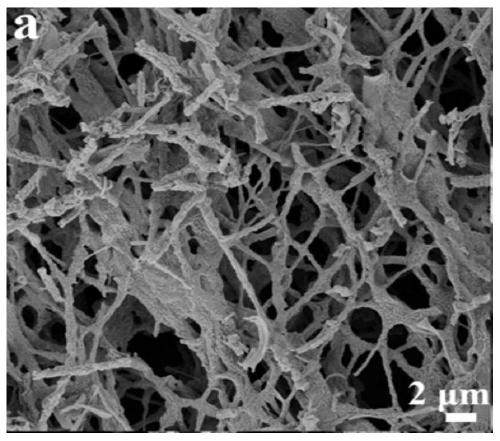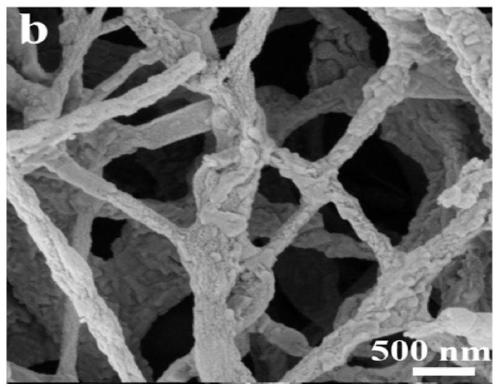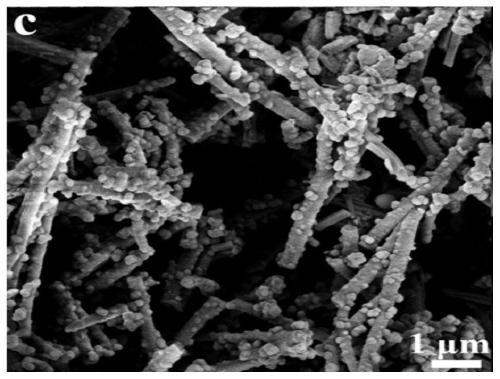A kind of copper phthalocyanine/γ-bismuth molybdate composite nanofiber photocatalytic material and its preparation method and application
A technology of composite nanofibers and photocatalytic materials, applied in the field of photocatalytic materials, can solve the problems of difficult recycling and reuse, high application cost, unfavorable photo-generated carrier transport and separation, etc., so as to improve photocatalytic efficiency, facilitate transport and Separating and enhancing the effect of photocatalytic efficiency
- Summary
- Abstract
- Description
- Claims
- Application Information
AI Technical Summary
Problems solved by technology
Method used
Image
Examples
Embodiment 1
[0064] A preparation method of copper phthalocyanine / γ-bismuth molybdate composite nanofiber photocatalytic material includes the following steps:
[0065] (1) Preparation of spinnable precursor sol: Dissolve 1.0 g of citric acid in 8 ml of deionized water at room temperature, and stir until dissolved; then add 0.177 g of ammonium molybdate and 0.970 g of bismuth nitrate pentahydrate to the above To the solution, add 1.6ml of 68% concentrated nitric acid and stir at room temperature for 2h to obtain a clear and transparent solution B; add 3ml of solution B and 1.5ml of 68% concentrated nitric acid to 15ml of absolute ethanol and mix at room temperature The solution D is uniformly obtained; 1.2 g of polyvinylpyrrolidone (PVP, K-90) is dissolved in the above solution D and stirred at room temperature for 15 hours to obtain a spinnable precursor sol.
[0066] (2) Preparation of γ-bismuth molybdate nanofibers: transfer the spinnable precursor sol obtained in step (1) into a 20ml plasti...
Embodiment 2
[0070] A preparation method of copper phthalocyanine / γ-bismuth molybdate composite nanofiber photocatalytic material includes the following steps:
[0071] (1) Preparation of spinnable precursor sol: Dissolve 2.5g of citric acid in 20ml of deionized water at room temperature, and stir until dissolved; then add 0.442g of ammonium molybdate and 2.425g of bismuth nitrate pentahydrate to the above To the solution, add 3ml of concentrated hydrochloric acid with a mass fraction of 37% and stir at room temperature for 1 hour to obtain a clear and transparent solution B. Add 2ml of solution B and 1.0ml of 37% concentrated hydrochloric acid to 10ml of absolute ethanol, mix well at room temperature to obtain solution D; dissolve 0.75g of polyvinylpyrrolidone (PVP, K-90) in the above solution D, After stirring at room temperature for 12 hours, a spinnable precursor sol was obtained.
[0072] (2) Preparation of γ-bismuth molybdate nanofibers: transfer the spinnable precursor sol obtained in s...
Embodiment 3
[0077] A preparation method of copper phthalocyanine / γ-bismuth molybdate composite nanofiber photocatalytic material includes the following steps:
[0078] (1) Preparation of spinnable precursor sol: Dissolve 2g of citric acid in 16ml of deionized water at room temperature and stir until dissolved; then add 0.353g of ammonium molybdate and 1.94g of bismuth nitrate pentahydrate to the above solution Then, add 2ml of concentrated hydrochloric acid with a mass fraction of 37% and stir at room temperature for 4 hours to obtain a clear and transparent solution B. Add 2ml of solution B and 2.0ml of 37% concentrated hydrochloric acid to 8ml of absolute ethanol, mix well at room temperature to obtain solution D; dissolve 1g of polyvinylpyrrolidone (PVP, K-90) in the above solution D at room temperature After 24 hours of stirring, a spinnable precursor sol is obtained.
[0079] (2) Preparation of γ-bismuth molybdate nanofibers: transfer the spinnable precursor sol obtained in step (1) into...
PUM
| Property | Measurement | Unit |
|---|---|---|
| diameter | aaaaa | aaaaa |
| length | aaaaa | aaaaa |
| diameter | aaaaa | aaaaa |
Abstract
Description
Claims
Application Information
 Login to View More
Login to View More - R&D
- Intellectual Property
- Life Sciences
- Materials
- Tech Scout
- Unparalleled Data Quality
- Higher Quality Content
- 60% Fewer Hallucinations
Browse by: Latest US Patents, China's latest patents, Technical Efficacy Thesaurus, Application Domain, Technology Topic, Popular Technical Reports.
© 2025 PatSnap. All rights reserved.Legal|Privacy policy|Modern Slavery Act Transparency Statement|Sitemap|About US| Contact US: help@patsnap.com



